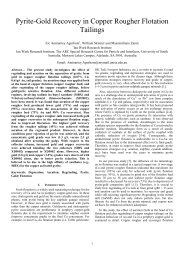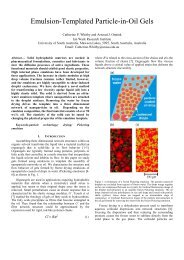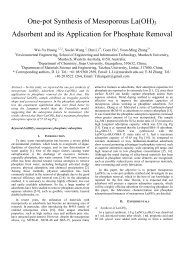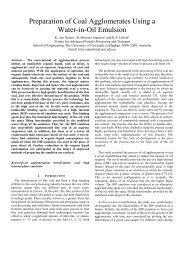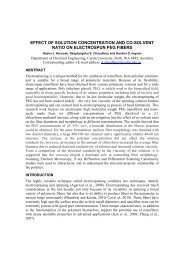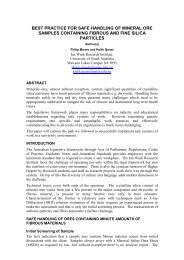Effect of Phyllosilicate Minerals on the Rheology, Colloidal and ...
Effect of Phyllosilicate Minerals on the Rheology, Colloidal and ...
Effect of Phyllosilicate Minerals on the Rheology, Colloidal and ...
- No tags were found...
You also want an ePaper? Increase the reach of your titles
YUMPU automatically turns print PDFs into web optimized ePapers that Google loves.
<str<strong>on</strong>g>Effect</str<strong>on</strong>g> <str<strong>on</strong>g>of</str<strong>on</strong>g> <str<strong>on</strong>g>Phyllosilicate</str<strong>on</strong>g> <str<strong>on</strong>g>Minerals</str<strong>on</strong>g> <strong>on</strong> <strong>the</strong> <strong>Rheology</strong>,<br />
<strong>Colloidal</strong> <strong>and</strong> Flotati<strong>on</strong> Behaviour <str<strong>on</strong>g>of</str<strong>on</strong>g> Chalcopyrite<br />
Mineral<br />
Saeed. Farrokhpay* <strong>and</strong> Bulelwa Ndlovu<br />
JKMRC, University <str<strong>on</strong>g>of</str<strong>on</strong>g> Queensl<strong>and</strong>, 40 Isles Road, Indooroopilly, QLD 4068, Australia<br />
* Email: s.farrokhpay@uq.edu.au<br />
Abstract- The effects <str<strong>on</strong>g>of</str<strong>on</strong>g> phyllosilicate minerals, namely<br />
illite, muscovite, talc, kaolinite <strong>and</strong> m<strong>on</strong>tmorill<strong>on</strong>ite, <strong>on</strong> <strong>the</strong><br />
flotati<strong>on</strong> <str<strong>on</strong>g>of</str<strong>on</strong>g> chalcopyrite were investigated. For this<br />
purpose, <strong>the</strong> effect <str<strong>on</strong>g>of</str<strong>on</strong>g> <strong>the</strong>se phyllosilicate minerals <strong>on</strong> <strong>the</strong><br />
froth stability, rheological properties, zeta potential as well<br />
as copper flotati<strong>on</strong> grade <strong>and</strong> recovery was investigated. It<br />
was found that various phyllosilicate minerals behave<br />
differently when added to <strong>the</strong> chalcopyrite slurries,<br />
however, <strong>the</strong>y all caused <strong>the</strong> flotati<strong>on</strong> grade to be reduced,<br />
albeit at different levels.<br />
The effect <str<strong>on</strong>g>of</str<strong>on</strong>g> different phyllosilicate minerals <strong>on</strong> <strong>the</strong> froth<br />
stability <str<strong>on</strong>g>of</str<strong>on</strong>g> chalcopyrite slurry followed <strong>the</strong> order <str<strong>on</strong>g>of</str<strong>on</strong>g><br />
m<strong>on</strong>tmorill<strong>on</strong>ite> muscovite >illite > kaolinite, talc. The<br />
effect <strong>on</strong> <strong>the</strong> rheology <str<strong>on</strong>g>of</str<strong>on</strong>g> chalcopyrite slurries was more or<br />
less negligible, except for m<strong>on</strong>tmorill<strong>on</strong>ite where <strong>the</strong><br />
suspensi<strong>on</strong> behaviour shifted from near Newt<strong>on</strong>ian to<br />
pseudoplastic.<br />
The effect <str<strong>on</strong>g>of</str<strong>on</strong>g> phyllosilicate minerals <strong>on</strong> <strong>the</strong> zeta potential <str<strong>on</strong>g>of</str<strong>on</strong>g><br />
chalcopyrite particles was also varied. While 30%<br />
m<strong>on</strong>tmorill<strong>on</strong>ite <strong>and</strong> kaolinite had a very minimal effect,<br />
additi<strong>on</strong> <str<strong>on</strong>g>of</str<strong>on</strong>g> 30% muscovite to <strong>the</strong> chalcopyrite slurry<br />
resulted in <strong>the</strong> zeta potential values being closer to <strong>the</strong><br />
pure muscovite suggesting full surface coverage <str<strong>on</strong>g>of</str<strong>on</strong>g><br />
chalcopyrite particles.<br />
M<strong>on</strong>tmorill<strong>on</strong>ite <strong>and</strong> talc had <strong>the</strong> most deleterious effect<br />
<strong>on</strong> chalcopyrite flotati<strong>on</strong>. The deleterious effect <str<strong>on</strong>g>of</str<strong>on</strong>g><br />
m<strong>on</strong>tmorill<strong>on</strong>ite is attributed to both rheology <strong>and</strong> froth<br />
stability. The deleterious effect <str<strong>on</strong>g>of</str<strong>on</strong>g> muscovite is also<br />
attributed to <strong>the</strong> surface coatings <str<strong>on</strong>g>of</str<strong>on</strong>g> <strong>the</strong> chalcopyrite<br />
particles.<br />
Keywords: <str<strong>on</strong>g>Phyllosilicate</str<strong>on</strong>g> minerals, chalcopyrite, flotati<strong>on</strong>,<br />
clays<br />
I. INTRODUCTION<br />
The difficulty <str<strong>on</strong>g>of</str<strong>on</strong>g> treating ores in <strong>the</strong> presence <str<strong>on</strong>g>of</str<strong>on</strong>g> clay minerals<br />
is well known in <strong>the</strong> mineral processing industry [1, 2]. Clay<br />
minerals have been named as <strong>on</strong>e <str<strong>on</strong>g>of</str<strong>on</strong>g> <strong>the</strong> main problems in<br />
leaching <strong>and</strong> milling processes due to <strong>the</strong>ir small size, which<br />
causes a higher viscosity in grinding <strong>and</strong> also blocks <strong>the</strong><br />
leaching path [3]. The situati<strong>on</strong> is hardly better in froth<br />
flotati<strong>on</strong>. For example, bent<strong>on</strong>ite can greatly depress coal<br />
flotati<strong>on</strong> by reducing <strong>the</strong> froth stability [4]. The effect <str<strong>on</strong>g>of</str<strong>on</strong>g> clay<br />
minerals <strong>on</strong> froth stability in flotati<strong>on</strong> has been recently<br />
reviewed [2].<br />
The various deleterious roles <str<strong>on</strong>g>of</str<strong>on</strong>g> clay minerals in froth flotati<strong>on</strong><br />
have been investigated by a number <str<strong>on</strong>g>of</str<strong>on</strong>g> authors [5-7]. The<br />
effects include i) surface coating <str<strong>on</strong>g>of</str<strong>on</strong>g> <strong>the</strong> mineral surfaces [8],<br />
ii) increasing reagent c<strong>on</strong>sumpti<strong>on</strong> due to <strong>the</strong>ir high surface<br />
area [9], iii) transferring large quantities <str<strong>on</strong>g>of</str<strong>on</strong>g> clay minerals into<br />
<strong>the</strong> c<strong>on</strong>centrate during <strong>the</strong> flotati<strong>on</strong> process, iv) increasing<br />
pulp viscosity [4], <strong>and</strong> v) changing froth stability (decreasing<br />
or increasing) [5, 10]. Even so, <strong>the</strong>re is still no clear<br />
underst<strong>and</strong>ing <str<strong>on</strong>g>of</str<strong>on</strong>g> <strong>the</strong> specific effects <str<strong>on</strong>g>of</str<strong>on</strong>g> different phyllosilicate<br />
minerals <strong>on</strong> froth flotati<strong>on</strong>. This is perhaps due to <strong>the</strong><br />
complexity that arises when dealing with multicomp<strong>on</strong>ent ore<br />
systems as has <str<strong>on</strong>g>of</str<strong>on</strong>g>ten been <strong>the</strong> case in <strong>the</strong> menti<strong>on</strong>ed studies.<br />
Moreover, different phyllosilicate minerals are likely to<br />
present dissimilar effects <strong>on</strong> flotati<strong>on</strong>, due to varying inherent<br />
hydrophobic or rheological properties.<br />
Froth stability is a key parameter in c<strong>on</strong>trolling <strong>and</strong> optimising<br />
<strong>the</strong> mineral grade <strong>and</strong> recovery in flotati<strong>on</strong>. It not <strong>on</strong>ly<br />
depends <strong>on</strong> <strong>the</strong> fro<strong>the</strong>r type <strong>and</strong> c<strong>on</strong>centrati<strong>on</strong>, but also <strong>on</strong> <strong>the</strong><br />
amount <strong>and</strong> nature <str<strong>on</strong>g>of</str<strong>on</strong>g> <strong>the</strong> suspended particles (particle<br />
hydrophobicity <strong>and</strong> size) [11]. These are <strong>the</strong>n inherent<br />
properties <str<strong>on</strong>g>of</str<strong>on</strong>g> <strong>the</strong> minerals <strong>and</strong> mineral type in <strong>the</strong> slurry. O<strong>the</strong>r<br />
parameters which could influence froth stability include <strong>the</strong><br />
quality <str<strong>on</strong>g>of</str<strong>on</strong>g> process water, gas dispersi<strong>on</strong>, particle c<strong>on</strong>tact angle,<br />
c<strong>on</strong>diti<strong>on</strong>ing <str<strong>on</strong>g>of</str<strong>on</strong>g> flotati<strong>on</strong> feed particles with various chemical<br />
reagents, froth height, temperature, salt c<strong>on</strong>centrati<strong>on</strong>, particle<br />
size <strong>and</strong> froth retenti<strong>on</strong> time [11, 12]. The froth stability <str<strong>on</strong>g>of</str<strong>on</strong>g><br />
mineral slurries has been successfully investigated at<br />
laboratory scale using a “froth column” [13, 14]. The effect <str<strong>on</strong>g>of</str<strong>on</strong>g><br />
phyllosilicate minerals <strong>on</strong> froth stability can be examined in a<br />
similar manner.
The suspensi<strong>on</strong> rheology is also important in determining <strong>the</strong><br />
hydrodynamics <strong>and</strong> dispersi<strong>on</strong> properties within <strong>the</strong> pulp<br />
phase. This, in turn, affects <strong>the</strong> minerals reporting to <strong>the</strong><br />
c<strong>on</strong>centrate. The rheological properties <str<strong>on</strong>g>of</str<strong>on</strong>g> mineral slurries are<br />
<str<strong>on</strong>g>of</str<strong>on</strong>g> great practical importance in many mineral processing<br />
applicati<strong>on</strong>s as <strong>the</strong>y are useful indicators <str<strong>on</strong>g>of</str<strong>on</strong>g> <strong>the</strong> degree <str<strong>on</strong>g>of</str<strong>on</strong>g><br />
aggregati<strong>on</strong> <strong>and</strong> dispersi<strong>on</strong> <str<strong>on</strong>g>of</str<strong>on</strong>g> particles within that suspensi<strong>on</strong><br />
[15, 16]. For example, <strong>the</strong> design <strong>and</strong> operati<strong>on</strong> <str<strong>on</strong>g>of</str<strong>on</strong>g> pumping<br />
systems <str<strong>on</strong>g>of</str<strong>on</strong>g> particulate suspensi<strong>on</strong>s is based <strong>on</strong> <strong>the</strong> viscosity<br />
<strong>and</strong> yield stress values. In such an applicati<strong>on</strong>, knowledge <str<strong>on</strong>g>of</str<strong>on</strong>g><br />
<strong>the</strong> yield stress is significant in ensuring <strong>the</strong> successful start-up<br />
<str<strong>on</strong>g>of</str<strong>on</strong>g> a pumping system from a static shut down c<strong>on</strong>diti<strong>on</strong>. The<br />
viscosity is an indicati<strong>on</strong> <str<strong>on</strong>g>of</str<strong>on</strong>g> <strong>the</strong> pumping requirements <strong>and</strong><br />
ease <str<strong>on</strong>g>of</str<strong>on</strong>g> flow <strong>the</strong>reafter. Studies linking <strong>the</strong> mineralogical<br />
c<strong>on</strong>tent <strong>and</strong> rheological resp<strong>on</strong>se have identified phyllosilicate<br />
gangue minerals as major c<strong>on</strong>tributors towards ore flow<br />
behaviour [17, 18]. This is supported by fundamental studies<br />
which have been c<strong>on</strong>ducted <strong>on</strong> pure phyllosilicate mineral<br />
suspensi<strong>on</strong>s, reporting significantly higher viscosities <strong>and</strong><br />
yield stresses in <strong>the</strong> presence <str<strong>on</strong>g>of</str<strong>on</strong>g> phyllosilicate minerals<br />
(particularly swelling clays <strong>and</strong> serpentine minerals) compared<br />
to n<strong>on</strong>-phyllosilicate mineral suspensi<strong>on</strong>s (e.g. quartz) [19,<br />
20]. The importance <str<strong>on</strong>g>of</str<strong>on</strong>g> rheology in mineral processing has<br />
also recently been reviewed [21].<br />
This study seeks to investigate <strong>the</strong> effects <str<strong>on</strong>g>of</str<strong>on</strong>g> different<br />
phyllosilicate minerals (namely illite, muscovite, talc,<br />
kaolinite <strong>and</strong> m<strong>on</strong>tmorill<strong>on</strong>ite) <strong>on</strong> <strong>the</strong> flotati<strong>on</strong> <str<strong>on</strong>g>of</str<strong>on</strong>g> chalcopyrite<br />
mineral. By using such a simplified model mineral system,<br />
ra<strong>the</strong>r than an ore comprising multicomp<strong>on</strong>ent mineral<br />
systems, <strong>the</strong> effects <str<strong>on</strong>g>of</str<strong>on</strong>g> <strong>the</strong> different phyllosilicate minerals can<br />
be better elucidated.<br />
II.<br />
A. Material<br />
MATERIAL AND EXPERIMENTALS METHODS<br />
Pure chalcopyrite, illite, talc, kaolinite, m<strong>on</strong>tmorill<strong>on</strong>ite <strong>and</strong><br />
muscovite were used in this study. Chalcopyrite single<br />
mineral, with a purity <str<strong>on</strong>g>of</str<strong>on</strong>g> more than 98%, was obtained from<br />
Ward’s Science (USA). Kaolinite Q38 (pre-ground) was<br />
provided by Unimin Australia Limited. All o<strong>the</strong>r phyllosilicate<br />
samples were obtained in a pre-ground form Ward’s Science.<br />
Potassium amyl xanthate (PAX) <strong>and</strong> MIBC, were used as<br />
collector <strong>and</strong> fro<strong>the</strong>r, respectively, in copper flotati<strong>on</strong>.<br />
Brisbane tap water was used throughout <strong>the</strong> study.<br />
B. Flotati<strong>on</strong><br />
200g <str<strong>on</strong>g>of</str<strong>on</strong>g> chalcopyrite was ground to P80 <str<strong>on</strong>g>of</str<strong>on</strong>g> 75 micr<strong>on</strong>s <strong>and</strong><br />
suspended in a 1L bottom driven flotati<strong>on</strong> cell. The flotati<strong>on</strong><br />
tests were c<strong>on</strong>ducted at 20% solid (by weight) at a pH <str<strong>on</strong>g>of</str<strong>on</strong>g> 8.<br />
This is within <strong>the</strong> pH range at which most industrial flotati<strong>on</strong><br />
runs are c<strong>on</strong>ducted. 100 g/t sodium alkyl xanthate (PAX) <strong>and</strong><br />
40 ppm MIBC were used as collector <strong>and</strong> fro<strong>the</strong>r, respectively.<br />
The pH was m<strong>on</strong>itored <strong>and</strong> adjusted if needed using KOH <strong>and</strong><br />
HCl. Three c<strong>on</strong>centrates were collected at 10 sec<strong>on</strong>ds intervals<br />
over 1, 3 <strong>and</strong> 5 minutes (cumulative).<br />
C. Froth stability tests<br />
Chalcopyrite was ground to P80 <str<strong>on</strong>g>of</str<strong>on</strong>g> 75 micr<strong>on</strong>s for froth<br />
stability tests. Varying c<strong>on</strong>centrati<strong>on</strong>s <str<strong>on</strong>g>of</str<strong>on</strong>g> each phyllosilicate<br />
were added to <strong>the</strong> pure chalcopyrite <strong>and</strong> <strong>the</strong> froth stability <str<strong>on</strong>g>of</str<strong>on</strong>g><br />
each slurry was assessed (at laboratory scale) using a specially<br />
designed froth stability column [22, 23]. The froth column<br />
c<strong>on</strong>sists <str<strong>on</strong>g>of</str<strong>on</strong>g> a 100 cm high acrylic column, with square 10 cm ×<br />
10 cm secti<strong>on</strong>, in which pulp samples are introduced for<br />
testing foaming proprieties. The column is provided with an<br />
impeller to ensure sufficient pulp agitati<strong>on</strong> <strong>and</strong> a porous plate<br />
at <strong>the</strong> bottom for uniform air diffusi<strong>on</strong>. Air flow is regulated<br />
by means <str<strong>on</strong>g>of</str<strong>on</strong>g> a flow-meter, <strong>and</strong> <strong>the</strong> same Jg as in flotati<strong>on</strong><br />
(1 cm/s) was maintained during <strong>the</strong> tests. A 2 L sample was<br />
c<strong>on</strong>diti<strong>on</strong>ed with <strong>the</strong> collector <strong>and</strong> fro<strong>the</strong>r <strong>and</strong> placed into <strong>the</strong><br />
apparatus. Once <strong>the</strong> pulp sample was introduced into <strong>the</strong><br />
column, <strong>the</strong> stirrer was turned <strong>on</strong>, in order to ensure sufficient<br />
agitati<strong>on</strong> <strong>and</strong> avoid settling <str<strong>on</strong>g>of</str<strong>on</strong>g> particles. At time t = 0, air was<br />
turned <strong>on</strong>, <strong>and</strong> froth height against time was measured, until<br />
an equilibrium value for <strong>the</strong> froth height H f0 was reached. At<br />
this point, air was turned <str<strong>on</strong>g>of</str<strong>on</strong>g>f, <strong>and</strong> froth decay measured. The<br />
half-life <str<strong>on</strong>g>of</str<strong>on</strong>g> <strong>the</strong> froth, i.e. <strong>the</strong> time needed for <strong>the</strong> froth to<br />
collapse to half its equilibrium height, was taken as an<br />
indicator for froth stability.<br />
D. <strong>Rheology</strong> measurements<br />
The rheology <str<strong>on</strong>g>of</str<strong>on</strong>g> suspensi<strong>on</strong>s <str<strong>on</strong>g>of</str<strong>on</strong>g> <strong>the</strong> chalcopyrite-phyllosilicate<br />
mixtures was analysed using an Ant<strong>on</strong> Paar DR301 rheometer.<br />
In each case, 60 mL <str<strong>on</strong>g>of</str<strong>on</strong>g> slurry was taken from <strong>the</strong> flotati<strong>on</strong> cell.<br />
Each suspensi<strong>on</strong> was stirred using a magnetic stirrer, ensuring<br />
homogeneity <strong>and</strong> suspensi<strong>on</strong> <str<strong>on</strong>g>of</str<strong>on</strong>g> particles prior to rheology<br />
testing. Measurements were c<strong>on</strong>ducted in triplicate for each<br />
slurries using a cup <strong>and</strong> bob geometry. The shear rate was<br />
adjusted from 2 to 300 s -1 , <strong>and</strong> <strong>the</strong>n reverse from 300 to 2 s -1<br />
<strong>and</strong> no significant hysteresis observed. The same tests were<br />
c<strong>on</strong>ducted <strong>on</strong> <strong>the</strong> flotati<strong>on</strong> tailings. Different equivalent<br />
c<strong>on</strong>centrati<strong>on</strong>s <str<strong>on</strong>g>of</str<strong>on</strong>g> pure chalcopyrite suspensi<strong>on</strong>s were also<br />
tested to determine if changes in rheological behaviour were<br />
due to ei<strong>the</strong>r increasing total solid c<strong>on</strong>centrati<strong>on</strong> or to <strong>the</strong><br />
effect <str<strong>on</strong>g>of</str<strong>on</strong>g> clay additi<strong>on</strong>.<br />
E. Zeta potential measurements<br />
The zeta potential <str<strong>on</strong>g>of</str<strong>on</strong>g> <strong>the</strong> chalcopyrite <strong>and</strong> phyllosilicate mineral<br />
samples was measured as a functi<strong>on</strong> <str<strong>on</strong>g>of</str<strong>on</strong>g> pH using a <strong>Colloidal</strong><br />
Dynamics ZetaProbe. 100 grams <str<strong>on</strong>g>of</str<strong>on</strong>g> chalcopyrite was ground to<br />
obtain P80 <str<strong>on</strong>g>of</str<strong>on</strong>g> 38 µm. The suspensi<strong>on</strong> was prepared <strong>and</strong> in<br />
0.001M NaCl soluti<strong>on</strong>. The pH was reduced from 10.5 to 4.5,<br />
using 0.2 M HCl <strong>and</strong> NaOH soluti<strong>on</strong>s to adjust <strong>the</strong> pH<br />
accordingly during measurement.<br />
III.<br />
RESULTS AND DISCUSSIONS
A. Flotati<strong>on</strong><br />
Figure 1 shows <strong>the</strong> changes in Cu grade <str<strong>on</strong>g>of</str<strong>on</strong>g> chalcopyrite up<strong>on</strong><br />
<strong>the</strong> additi<strong>on</strong> <str<strong>on</strong>g>of</str<strong>on</strong>g> varying c<strong>on</strong>centrati<strong>on</strong>s <str<strong>on</strong>g>of</str<strong>on</strong>g> each phyllosilicate.<br />
The Cu flotati<strong>on</strong> recovery was unchanged at about 90%, with<br />
or without additi<strong>on</strong> <str<strong>on</strong>g>of</str<strong>on</strong>g> phyllosilicate minerals. However, <strong>the</strong><br />
Cu grades were lower in <strong>the</strong> presence <str<strong>on</strong>g>of</str<strong>on</strong>g> all tested<br />
phyllosilicate minerals. The Cu grade <str<strong>on</strong>g>of</str<strong>on</strong>g> pure chalcopyrite<br />
flotati<strong>on</strong> is 34.8% (calculated based <strong>on</strong> Cu in CuFeS 2 ). Figure<br />
1 shows that with <strong>the</strong> additi<strong>on</strong> <str<strong>on</strong>g>of</str<strong>on</strong>g> <strong>the</strong> maximum tested amount<br />
<str<strong>on</strong>g>of</str<strong>on</strong>g> illite, kaolinite <strong>and</strong> muscovite, <strong>the</strong> Cu grade decreases (from<br />
34.8%) to about 30%, 28% <strong>and</strong> 26.5%, respectively. The Cu<br />
grade decreases dramatically to 22% when 30% <str<strong>on</strong>g>of</str<strong>on</strong>g> talc or 15%<br />
<str<strong>on</strong>g>of</str<strong>on</strong>g> m<strong>on</strong>tmorill<strong>on</strong>ite was added to <strong>the</strong> chalcopyrite flotati<strong>on</strong>.<br />
Talc is known to be hydrophobic <strong>and</strong> <strong>on</strong>e may expect it to<br />
float during mineral flotati<strong>on</strong>. Therefore, it is <str<strong>on</strong>g>of</str<strong>on</strong>g>ten depressed<br />
in industry by using a depressant such as CMC or guar gum<br />
[24].<br />
<strong>the</strong> froth stability results may need fur<strong>the</strong>r validati<strong>on</strong> as talc<br />
had a str<strong>on</strong>g tendency to stick to <strong>the</strong> froth column walls during<br />
testing, making analysis particularly difficult.<br />
Figure 2: <str<strong>on</strong>g>Effect</str<strong>on</strong>g> <str<strong>on</strong>g>of</str<strong>on</strong>g> phyllosilicate minerals (illite , kaolinite ■, muscovite ▲,<br />
m<strong>on</strong>tmorill<strong>on</strong>ite ●, <strong>and</strong> talc x) <strong>on</strong> <strong>the</strong> froth stability (half-life) <str<strong>on</strong>g>of</str<strong>on</strong>g> chalcopyrite<br />
suspensi<strong>on</strong><br />
Figure 1: <str<strong>on</strong>g>Effect</str<strong>on</strong>g> <str<strong>on</strong>g>of</str<strong>on</strong>g> phyllosilicate minerals (illite , kaolinite ■, muscovite ▲,<br />
m<strong>on</strong>tmorill<strong>on</strong>ite ●, <strong>and</strong> talc x) <strong>on</strong> <strong>the</strong> copper grade in chalcopyrite flotati<strong>on</strong><br />
(Cu flotati<strong>on</strong> recovery unchanged at about 90%).<br />
C. <strong>Rheology</strong><br />
Figure 3 shows <strong>the</strong> rheograms <str<strong>on</strong>g>of</str<strong>on</strong>g> pure chalcopyrite<br />
suspensi<strong>on</strong>s at increasing solid c<strong>on</strong>centrati<strong>on</strong>. These tests were<br />
c<strong>on</strong>ducted to gauge whe<strong>the</strong>r any changes in rheology could be<br />
attributed to chalcopyrite or to <strong>the</strong> added phyllosilicate<br />
minerals. The results show a similar rheological trend for<br />
chalcopyrite c<strong>on</strong>centrati<strong>on</strong>s between 20 to 30%. However,<br />
<strong>the</strong>re is a c<strong>on</strong>siderable increase in <strong>the</strong> slurry viscosity at 40%<br />
solid by weight. These results suggest that in <strong>the</strong> range <str<strong>on</strong>g>of</str<strong>on</strong>g> total<br />
solids c<strong>on</strong>centrati<strong>on</strong> up to 30% (by wt.), any change in <strong>the</strong><br />
chalcopyrite slurry rheology, after additi<strong>on</strong> <str<strong>on</strong>g>of</str<strong>on</strong>g> phyllosilicate<br />
minerals is indeed due to <strong>the</strong> phyllosilicate additi<strong>on</strong> <strong>and</strong> not a<br />
result <str<strong>on</strong>g>of</str<strong>on</strong>g> <strong>the</strong> increased solid c<strong>on</strong>centrati<strong>on</strong> <str<strong>on</strong>g>of</str<strong>on</strong>g> <strong>the</strong> chalcopyrite.<br />
In order to underst<strong>and</strong> <strong>the</strong> effect <str<strong>on</strong>g>of</str<strong>on</strong>g> phyllosilicate minerals <strong>on</strong><br />
<strong>the</strong> chalcopyrite flotati<strong>on</strong>, froth stability, rheology <strong>and</strong> zeta<br />
potential measurements were c<strong>on</strong>ducted, which are discussed<br />
in <strong>the</strong> following secti<strong>on</strong>s.<br />
B. Froth stability<br />
Figure 2 shows <strong>the</strong> changes in froth half-life (froth stability)<br />
up<strong>on</strong> <strong>the</strong> additi<strong>on</strong> <str<strong>on</strong>g>of</str<strong>on</strong>g> different phyllosilicate minerals. It can be<br />
seen that m<strong>on</strong>tmorill<strong>on</strong>ite <strong>and</strong> muscovite have a noticeable<br />
effect <strong>on</strong> <strong>the</strong> froth stability <str<strong>on</strong>g>of</str<strong>on</strong>g> chalcopyrite suspensi<strong>on</strong>. The<br />
froth height increases by 20-25% with <strong>the</strong> additi<strong>on</strong> <str<strong>on</strong>g>of</str<strong>on</strong>g><br />
m<strong>on</strong>tmorill<strong>on</strong>ite <strong>and</strong> muscovite to <strong>the</strong> mineral suspensi<strong>on</strong>. On<br />
<strong>the</strong> o<strong>the</strong>r h<strong>and</strong>, illite has less effect, <strong>and</strong> both kaolinite <strong>and</strong> talc<br />
have a negligible effect. Therefore, <strong>the</strong> effect <str<strong>on</strong>g>of</str<strong>on</strong>g> different<br />
phyllosilicate minerals <strong>on</strong> <strong>the</strong> froth stability <str<strong>on</strong>g>of</str<strong>on</strong>g> chalcopyrite<br />
suspensi<strong>on</strong> follows <strong>the</strong> order <str<strong>on</strong>g>of</str<strong>on</strong>g> m<strong>on</strong>tmorill<strong>on</strong>ite> muscovite><br />
illite> kaolinite <strong>and</strong> talc. M<strong>on</strong>tmorill<strong>on</strong>ite dem<strong>on</strong>strated <strong>the</strong><br />
most noticeable effect <strong>on</strong> froth stability <strong>and</strong>, at <strong>the</strong> same time,<br />
it has a major deleterious effect <strong>on</strong> chalcopyrite flotati<strong>on</strong><br />
(Figure 1). Talc, <strong>on</strong> <strong>the</strong> o<strong>the</strong>r h<strong>and</strong>, which has <strong>the</strong> same effect<br />
<strong>on</strong> <strong>the</strong> copper flotati<strong>on</strong> grade seems to have a very minimal<br />
effect <strong>on</strong> <strong>the</strong> froth stability. It should be noted, however, that<br />
Figure 3: <strong>Rheology</strong> <str<strong>on</strong>g>of</str<strong>on</strong>g> chalcopyrite slurry as a functi<strong>on</strong> <str<strong>on</strong>g>of</str<strong>on</strong>g> solid%; for 20%▲,<br />
30% □, <strong>and</strong> 40% ○.<br />
Figures 4 <strong>and</strong> 5 also show <strong>the</strong> rheograms <str<strong>on</strong>g>of</str<strong>on</strong>g> suspensi<strong>on</strong>s<br />
c<strong>on</strong>taining chalcopyrite <strong>and</strong> varying c<strong>on</strong>centrati<strong>on</strong>s <str<strong>on</strong>g>of</str<strong>on</strong>g> each<br />
phyllosilicate. The results show that <strong>the</strong>re is no marginal<br />
rheological effect observed for all phyllosilicate minerals o<strong>the</strong>r<br />
than m<strong>on</strong>tmorill<strong>on</strong>ite.<br />
Figure 5 shows that m<strong>on</strong>tmorill<strong>on</strong>ite c<strong>on</strong>siderably affects <strong>the</strong><br />
chalcopyrite slurry rheology. Additi<strong>on</strong> <str<strong>on</strong>g>of</str<strong>on</strong>g> 5 to 10%<br />
m<strong>on</strong>tmorill<strong>on</strong>ite causes a slight change in <strong>the</strong> rheology <str<strong>on</strong>g>of</str<strong>on</strong>g>
chalcopyrite slurry. However, a different rheological<br />
behaviour with a yield stress is observed by additi<strong>on</strong> <str<strong>on</strong>g>of</str<strong>on</strong>g> 15%<br />
m<strong>on</strong>tmorill<strong>on</strong>ite. The significant change in <strong>the</strong> rheology can<br />
be related to <strong>the</strong> c<strong>on</strong>siderable effect m<strong>on</strong>tmorill<strong>on</strong>ite had <strong>on</strong><br />
<strong>the</strong> froth stability, compared to <strong>the</strong> o<strong>the</strong>r four phyllosilicate<br />
minerals tested in this study. In fact, when <strong>the</strong> effects <str<strong>on</strong>g>of</str<strong>on</strong>g> <strong>the</strong><br />
phyllosilicate minerals <strong>on</strong> <strong>the</strong> rheology <str<strong>on</strong>g>of</str<strong>on</strong>g> chalcopyrite slurry<br />
are compared to each o<strong>the</strong>r, <strong>the</strong> prominent effect <str<strong>on</strong>g>of</str<strong>on</strong>g><br />
m<strong>on</strong>tmorill<strong>on</strong>ite is very clear.<br />
The extreme rheological effects observed for m<strong>on</strong>tmorill<strong>on</strong>ite<br />
are in agreement with <strong>the</strong> results <str<strong>on</strong>g>of</str<strong>on</strong>g> Ndlovu et al. [25], which<br />
dem<strong>on</strong>strated a ‘critical’ c<strong>on</strong>centrati<strong>on</strong> <str<strong>on</strong>g>of</str<strong>on</strong>g> < 4% by volume for<br />
pure m<strong>on</strong>tmorill<strong>on</strong>ite, while this occurs at much higher<br />
c<strong>on</strong>centrati<strong>on</strong>s for <strong>the</strong> o<strong>the</strong>r minerals in <strong>the</strong>ir pure form (><br />
15% solids by volume).<br />
Figure 4: <str<strong>on</strong>g>Effect</str<strong>on</strong>g> <str<strong>on</strong>g>of</str<strong>on</strong>g> kaolinite, illite, talc <strong>and</strong> muscovite <strong>on</strong> <strong>the</strong> chalcopyrite<br />
slurry (20 wt%) rheology as a functi<strong>on</strong> <str<strong>on</strong>g>of</str<strong>on</strong>g> solid% <str<strong>on</strong>g>of</str<strong>on</strong>g> phyllosilicate minerals<br />
(0% +, 10% □, 20%▲ <strong>and</strong> 30% ●).
Figure 7 shows <strong>the</strong> zeta potential curves <str<strong>on</strong>g>of</str<strong>on</strong>g> suspensi<strong>on</strong>s <str<strong>on</strong>g>of</str<strong>on</strong>g><br />
each phyllosilicate <strong>and</strong> chalcopyrite-phyllosilicate mixtures (at<br />
varying mixture c<strong>on</strong>centrati<strong>on</strong>s). The results show that <strong>the</strong> zeta<br />
potential <str<strong>on</strong>g>of</str<strong>on</strong>g> chalcopyrite with 30% m<strong>on</strong>tmorill<strong>on</strong>ite <strong>and</strong><br />
kaolinite is very close to that <str<strong>on</strong>g>of</str<strong>on</strong>g> pure chalcopyrite particles.<br />
However, additi<strong>on</strong> <str<strong>on</strong>g>of</str<strong>on</strong>g> 30% muscovite to <strong>the</strong> chalcopyrite<br />
suspensi<strong>on</strong> results in zeta potential values closer to <strong>the</strong> pure<br />
muscovite, which may suggest full surface coverage <str<strong>on</strong>g>of</str<strong>on</strong>g><br />
chalcopyrite particles with muscovite. Additi<strong>on</strong> <str<strong>on</strong>g>of</str<strong>on</strong>g> 30% talc<br />
<strong>and</strong> illite to <strong>the</strong> chalcopyrite suspensi<strong>on</strong> also results in zeta<br />
potential values shifting between that <str<strong>on</strong>g>of</str<strong>on</strong>g> chalcopyrite <strong>and</strong><br />
<strong>the</strong>se phyllosilicate minerals, as <strong>on</strong>e may expect from partial<br />
surface coatings <str<strong>on</strong>g>of</str<strong>on</strong>g> chalcopyrite particles. A similar behaviour<br />
can be seen when 10% <str<strong>on</strong>g>of</str<strong>on</strong>g> all phyllosilicate minerals is added<br />
to <strong>the</strong> chalcopyrite suspensi<strong>on</strong>.<br />
Figure 5: <str<strong>on</strong>g>Effect</str<strong>on</strong>g> <str<strong>on</strong>g>of</str<strong>on</strong>g> M<strong>on</strong>tmorill<strong>on</strong>ite (0% +, 5% □, 10%▲, <strong>and</strong> 15% ●) <strong>on</strong> <strong>the</strong><br />
chalcopyrite slurry (20 wt%) rheology.<br />
D. Zeta potential<br />
Figure 6 shows <strong>the</strong> zeta potential curves <str<strong>on</strong>g>of</str<strong>on</strong>g> pure<br />
chalocopyrite. The results show that <strong>the</strong> zeta potential <str<strong>on</strong>g>of</str<strong>on</strong>g><br />
chalcopyrite is about -25 mV at pH above 8.5. However below<br />
pH <str<strong>on</strong>g>of</str<strong>on</strong>g> 8.5, <strong>the</strong> zeta potential becomes less negative, reaching<br />
<strong>the</strong> iso electric point (iep) at pH about 5.5. Therefore, it is<br />
negatively charged across <strong>the</strong> pH examined in this project (pH<br />
8). The iep <str<strong>on</strong>g>of</str<strong>on</strong>g> n<strong>on</strong>-oxidized chalcopyrite in different salt<br />
soluti<strong>on</strong>s has been reported to be between pH 4-5 [12]. The<br />
observed zeta potential is <strong>the</strong>n within <strong>the</strong> range <str<strong>on</strong>g>of</str<strong>on</strong>g> previously<br />
reported values. However, Peng <strong>and</strong> Zhang [26] have reported<br />
<strong>the</strong> iep <str<strong>on</strong>g>of</str<strong>on</strong>g> chalcopyrite, after grinding with peroxide, exhibited<br />
at around pH 8.5, indicating str<strong>on</strong>g oxidati<strong>on</strong>. Sulfide minerals<br />
get oxidised quickly <strong>and</strong> <strong>the</strong>refore <strong>the</strong> zeta potential does vary.<br />
Figure 6: Zeta potential <str<strong>on</strong>g>of</str<strong>on</strong>g> chalcopyrite (repeated 4 times with 95%<br />
c<strong>on</strong>fidence).<br />
CONCLUSIONS<br />
Various phyllosilicate minerals were found to behave<br />
differently when added to <strong>the</strong> chalcopyrite slurry, however,<br />
<strong>the</strong>y all caused <strong>the</strong> flotati<strong>on</strong> grade to be reduced. Additi<strong>on</strong> <str<strong>on</strong>g>of</str<strong>on</strong>g><br />
<strong>the</strong> maximum tested amount <str<strong>on</strong>g>of</str<strong>on</strong>g> illite, kaolinite <strong>and</strong> muscovite<br />
caused <strong>the</strong> Cu grade to decrease (from 34.8%) to about 30%,<br />
28% <strong>and</strong> 26.5%, respectively (at <strong>the</strong> same flotati<strong>on</strong> recovery).<br />
The Cu grade was also decreased dramatically to about 22%<br />
when 30% talc or 15% m<strong>on</strong>tmorill<strong>on</strong>ite was added to <strong>the</strong><br />
chalcopyrite flotati<strong>on</strong>. Therefore, <strong>the</strong> effect <str<strong>on</strong>g>of</str<strong>on</strong>g> phyllosilicate<br />
minerals <strong>on</strong> <strong>the</strong> flotati<strong>on</strong> <str<strong>on</strong>g>of</str<strong>on</strong>g> chalcopyrite can be ranked as talc,<br />
m<strong>on</strong>tmorill<strong>on</strong>ite> muscovite> kaolinite> illite.<br />
The ranking for different phyllosilicate minerals <strong>on</strong> <strong>the</strong> froth<br />
stability <str<strong>on</strong>g>of</str<strong>on</strong>g> chalcopyrite slurry followed <strong>the</strong> order <str<strong>on</strong>g>of</str<strong>on</strong>g><br />
m<strong>on</strong>tmorill<strong>on</strong>ite > muscovite >illite > kaolinite, talc.<br />
An increase in <strong>the</strong> c<strong>on</strong>centrati<strong>on</strong> <str<strong>on</strong>g>of</str<strong>on</strong>g> each phyllosilicate mineral<br />
resulted in more complex suspensi<strong>on</strong> rheology, but <strong>the</strong> effect<br />
was negligible except for m<strong>on</strong>tmorill<strong>on</strong>ite where <strong>the</strong><br />
suspensi<strong>on</strong> behaviour shifted from near Newt<strong>on</strong>ian to<br />
pseudoplastic.<br />
The effect <str<strong>on</strong>g>of</str<strong>on</strong>g> phyllosilicate minerals <strong>on</strong> <strong>the</strong> zeta potential <str<strong>on</strong>g>of</str<strong>on</strong>g><br />
chalcopyrite particles was varied. While 30% m<strong>on</strong>tmorill<strong>on</strong>ite<br />
<strong>and</strong> kaolinite had a very minimal effect, additi<strong>on</strong> <str<strong>on</strong>g>of</str<strong>on</strong>g> 30%<br />
muscovite to <strong>the</strong> chalcopyrite slurry resulted in <strong>the</strong> zeta<br />
potential values being closer to <strong>the</strong> pure muscovite suggesting<br />
full surface coverage <str<strong>on</strong>g>of</str<strong>on</strong>g> chalcopyrite particles. Additi<strong>on</strong> <str<strong>on</strong>g>of</str<strong>on</strong>g><br />
30% talc <strong>and</strong> illite to <strong>the</strong> chalcopyrite suspensi<strong>on</strong> also resulted<br />
in zeta potential values shifting between that <str<strong>on</strong>g>of</str<strong>on</strong>g> chalcopyrite<br />
<strong>and</strong> <strong>the</strong>se phyllosilicate minerals, as <strong>on</strong>e may expect from<br />
partial surface coverage.<br />
M<strong>on</strong>tmorill<strong>on</strong>ite <strong>and</strong> talc were found to have <strong>the</strong> most effect<br />
<strong>on</strong> chalcopyrite flotati<strong>on</strong>. From this study, <strong>the</strong> deleterious<br />
effect <str<strong>on</strong>g>of</str<strong>on</strong>g> m<strong>on</strong>tmorill<strong>on</strong>ite can be related to both rheology <strong>and</strong><br />
froth stability. The deleterious effect <str<strong>on</strong>g>of</str<strong>on</strong>g> muscovite can also be<br />
related to <strong>the</strong> surface coatings <str<strong>on</strong>g>of</str<strong>on</strong>g> <strong>the</strong> chalcopyrite particles (as<br />
observed in <strong>the</strong> zeta potential results) which also affect <strong>the</strong><br />
froth stability. There is no evidence in this study to support <strong>the</strong>
Kaolinite<br />
Illite<br />
Talc<br />
deleterious effect <str<strong>on</strong>g>of</str<strong>on</strong>g> talc, however, <strong>on</strong>e may relate it to <strong>the</strong><br />
ability <str<strong>on</strong>g>of</str<strong>on</strong>g> talc to float <strong>and</strong> decrease <strong>the</strong> c<strong>on</strong>centrati<strong>on</strong> grade, as<br />
it is a naturally hydroph<strong>on</strong>e phyllosilicate mineral.<br />
M<strong>on</strong>tmorill<strong>on</strong>ite <strong>and</strong> talc were found to have <strong>the</strong> most effect<br />
<strong>on</strong> chalcopyrite flotati<strong>on</strong>. From this study, <strong>the</strong> deleterious<br />
effect <str<strong>on</strong>g>of</str<strong>on</strong>g> m<strong>on</strong>tmorill<strong>on</strong>ite can be related to both rheology <strong>and</strong><br />
froth stability. The deleterious effect <str<strong>on</strong>g>of</str<strong>on</strong>g> muscovite can also be<br />
related to <strong>the</strong> surface coatings <str<strong>on</strong>g>of</str<strong>on</strong>g> <strong>the</strong> chalcopyrite particles (as<br />
observed in <strong>the</strong> zeta potential results) which also affect <strong>the</strong><br />
froth stability. There is no evidence in this study to support <strong>the</strong><br />
deleterious effect <str<strong>on</strong>g>of</str<strong>on</strong>g> talc, however, <strong>on</strong>e may relate it to <strong>the</strong><br />
ability <str<strong>on</strong>g>of</str<strong>on</strong>g> talc to float <strong>and</strong> decrease <strong>the</strong> c<strong>on</strong>centrati<strong>on</strong> grade, as<br />
it is a naturally hydroph<strong>on</strong>e phyllosilicate mineral.<br />
The study undertaken here was c<strong>on</strong>ducted in a simplistic<br />
manner. Indeed, <strong>the</strong> phyllosilicate minerals behave differently<br />
with different effects <strong>on</strong> flotati<strong>on</strong> performance. While not<br />
underpinning <strong>the</strong> specific effects <str<strong>on</strong>g>of</str<strong>on</strong>g> <strong>the</strong> minerals, this study<br />
has aided in better underst<strong>and</strong>ing <strong>the</strong> exact effects <str<strong>on</strong>g>of</str<strong>on</strong>g> each<br />
mineral. More rigorous analysis would be required for in<br />
depth underst<strong>and</strong>ing.<br />
ACKNOWLEDGMENT<br />
The authors would like to acknowledge Yang Jiang, Annie<br />
Nguyen <strong>and</strong> Elisheba Radke for practical testwork during <strong>the</strong>ir<br />
summer vacati<strong>on</strong> project at <strong>the</strong> JKMRC.<br />
Muscovite<br />
M<strong>on</strong>tmorill<strong>on</strong>ite<br />
Figure 7: Zeta potential <str<strong>on</strong>g>of</str<strong>on</strong>g> chalcopyrite (●), phyllosilicate (as marked) (■),<br />
<strong>and</strong> chalcopyrite/ phyllosilicate mixed suspensi<strong>on</strong>s (10% ▲; <strong>and</strong> 30% ◊<br />
phyllosilicate).<br />
REFERENCES<br />
[1] Cruz, N, Peng, Y, Farrokhpay, S, <strong>and</strong> Bradshaw, D: Interacti<strong>on</strong>s <str<strong>on</strong>g>of</str<strong>on</strong>g> clay<br />
minerals in copper-gold flotati<strong>on</strong>: Part 1 - rheological properties <str<strong>on</strong>g>of</str<strong>on</strong>g> clay<br />
mineral suspensi<strong>on</strong>s in <strong>the</strong> presence <str<strong>on</strong>g>of</str<strong>on</strong>g> flotati<strong>on</strong> reagents, Miner. Eng.,<br />
50-51, pp. 30–37, 2013.<br />
[2] Farrokhpay, S <strong>and</strong> Bradshaw, D: <str<strong>on</strong>g>Effect</str<strong>on</strong>g> <str<strong>on</strong>g>of</str<strong>on</strong>g> clay minerals <strong>on</strong> froth stability<br />
in mineral flotati<strong>on</strong>: a review, in Proceeding <str<strong>on</strong>g>of</str<strong>on</strong>g> XXVI Internati<strong>on</strong>al<br />
Mineral Processing C<strong>on</strong>gress, New Delhi, 2012, pp. 4601-4611.<br />
[3] Tremolada, J, Dzioba, R, Bernardo-Sánchez, A, <strong>and</strong> Menéndez-Aguado,<br />
JM: The Preg-robbing <str<strong>on</strong>g>of</str<strong>on</strong>g> gold <strong>and</strong> silver by clays during cyanidati<strong>on</strong><br />
under agitati<strong>on</strong> <strong>and</strong> heap leaching c<strong>on</strong>diti<strong>on</strong>s, Int. J. Miner. Process., 94,<br />
pp. 67-71, 2010.<br />
[4] Arnold, BJ <strong>and</strong> Aplan, FF: The effect <str<strong>on</strong>g>of</str<strong>on</strong>g> clay slimes <strong>on</strong> coal flotati<strong>on</strong>,<br />
part I: <strong>the</strong> nature <str<strong>on</strong>g>of</str<strong>on</strong>g> <strong>the</strong> clay, Int. J. Miner. Process., 17, pp. 225-242,<br />
1986.<br />
[5] Bulatovic, SM: H<strong>and</strong>book <str<strong>on</strong>g>of</str<strong>on</strong>g> Flotati<strong>on</strong> Reagents: Chemistry, Theory <strong>and</strong><br />
Practice: Flotati<strong>on</strong> <str<strong>on</strong>g>of</str<strong>on</strong>g> Sulphide Ores, Elsevier, Bost<strong>on</strong>, 2007.<br />
[6] Bulatovic, SM, Wyslouzil, DM, <strong>and</strong> Kant, C: <str<strong>on</strong>g>Effect</str<strong>on</strong>g> <str<strong>on</strong>g>of</str<strong>on</strong>g> clay slimes <strong>on</strong><br />
copper, molybdenum flotati<strong>on</strong> from porphyry ores, in Proceeding <str<strong>on</strong>g>of</str<strong>on</strong>g><br />
Copper 99-Cober 99 Internati<strong>on</strong>al C<strong>on</strong>ference, Phoenix, 1999, pp. 95-<br />
111.<br />
[7] Jorjani, E, Barkhordari, HR, Tayebi Khorami, M, <strong>and</strong> Fazeli, A: <str<strong>on</strong>g>Effect</str<strong>on</strong>g>s<br />
<str<strong>on</strong>g>of</str<strong>on</strong>g> aluminosilicate minerals <strong>on</strong> copper–molybdenum flotati<strong>on</strong> from<br />
Sarcheshmeh porphyry ores, Miner. Eng., 24, pp. 754-759, 2011.<br />
[8] Tao, D, Dopico, PG, Hines, J, <strong>and</strong> Kennedy, D: An experimental study <str<strong>on</strong>g>of</str<strong>on</strong>g><br />
clay binders in fine coal froth flotati<strong>on</strong>, in Proceeding <str<strong>on</strong>g>of</str<strong>on</strong>g> Internati<strong>on</strong>al<br />
Coal Preparati<strong>on</strong> C<strong>on</strong>gress, Lexingt<strong>on</strong>, USA, Society for Mining,<br />
Metallurgy, <strong>and</strong> Explorati<strong>on</strong> (SME), 2010, pp. 478-487.<br />
[9] Cazerlend, KA <strong>and</strong> Uork, LB: Flotati<strong>on</strong> principals, Metallurgizdaf,<br />
Russia, pp. 1958.<br />
[10] Dippenaar, A: The <str<strong>on</strong>g>Effect</str<strong>on</strong>g> <str<strong>on</strong>g>of</str<strong>on</strong>g> Particles <strong>on</strong> <strong>the</strong> Stability <str<strong>on</strong>g>of</str<strong>on</strong>g> Flotati<strong>on</strong> Froth,<br />
Report No. 81, IMM, South Africa, pp. 1988.<br />
[11] Farrokhpay, S: The significance <str<strong>on</strong>g>of</str<strong>on</strong>g> froth stability in mineral flotati<strong>on</strong>- a<br />
review, Adv. Colloid Interface Sci., 166, pp. 1-7, 2011.
[12] Sinche G<strong>on</strong>zalez, MM, Fornasiero, D, <strong>and</strong> Levay, G: <str<strong>on</strong>g>Effect</str<strong>on</strong>g> <str<strong>on</strong>g>of</str<strong>on</strong>g> water<br />
quality <strong>on</strong> chalcopyrite <strong>and</strong> molybdenite flotati<strong>on</strong> in Proceeding <str<strong>on</strong>g>of</str<strong>on</strong>g><br />
Chemeca, Adelaide, 2010, pp.<br />
[13] Farrokhpay, S <strong>and</strong> Zanin, M: Synergic effect <str<strong>on</strong>g>of</str<strong>on</strong>g> collector <strong>and</strong> fro<strong>the</strong>r <strong>on</strong><br />
froth stability <strong>and</strong> flotati<strong>on</strong> recovery – an industrial case, in Proceeding<br />
<str<strong>on</strong>g>of</str<strong>on</strong>g> 11 th Mill Operators' C<strong>on</strong>ference, Hobart, The Australasian Institute <str<strong>on</strong>g>of</str<strong>on</strong>g><br />
Mining <strong>and</strong> Metallurgy AusiMM, 2012, pp. 145-150.<br />
[14] Zanin, M, Wightman, E, Grano, SR, <strong>and</strong> Franzidis, J-P: Froth stability<br />
as a performance indicator in sulphide minerals flotati<strong>on</strong> plants, in<br />
Proceeding <str<strong>on</strong>g>of</str<strong>on</strong>g> Chemeca 2007: Academia <strong>and</strong> Industry - Streng<strong>the</strong>ning<br />
<strong>the</strong> Pr<str<strong>on</strong>g>of</str<strong>on</strong>g>essi<strong>on</strong>, Melbourne, 2007, pp. 350-357.<br />
[15] Johns<strong>on</strong>, SB, Franks, GV, Scales, PJ, Boger, DV, <strong>and</strong> Healy, TW:<br />
Surface chemistry-rheology relati<strong>on</strong>ships in c<strong>on</strong>centrated mineral<br />
suspensi<strong>on</strong>s, Int. J. Miner. Process., 58, pp. 267-304, 2000.<br />
[16] Luckham, PF <strong>and</strong> Rossi, S: The colloidal <strong>and</strong> rheological properties <str<strong>on</strong>g>of</str<strong>on</strong>g><br />
bent<strong>on</strong>ite suspensi<strong>on</strong>s, Adv. Colloid Interface Sci., 82, pp. 43-92, 1999.<br />
[17] Burdukova, E, Becker, M, Ndlovu, B, Mokgethi, B, <strong>and</strong> Degl<strong>on</strong>, DA:<br />
Relati<strong>on</strong>ship between slurry rheology <strong>and</strong> its mineralogical c<strong>on</strong>tent, in<br />
Proceeding <str<strong>on</strong>g>of</str<strong>on</strong>g> XXIV Internati<strong>on</strong>al <str<strong>on</strong>g>Minerals</str<strong>on</strong>g> Processing C<strong>on</strong>gress,<br />
Beijing, China Scientific Book Service Co. Ltd Beijing, 2008, pp. 2169-<br />
2178.<br />
[18] Shabalala, NZP, Harris, M, Leal Filho, LS, <strong>and</strong> Degl<strong>on</strong>, DA: <str<strong>on</strong>g>Effect</str<strong>on</strong>g> <str<strong>on</strong>g>of</str<strong>on</strong>g><br />
slurry rheology <strong>on</strong> gas dispersi<strong>on</strong> in a pilot-scale mechanical flotati<strong>on</strong><br />
cell, Miner. Eng., 24, pp. 1448-1453, 2011.<br />
[19] Ndlovu, BN, Becker, M, Forbes, E, Degl<strong>on</strong>, DA, <strong>and</strong> Franzidis, JP: The<br />
influence <str<strong>on</strong>g>of</str<strong>on</strong>g> phyllosilicate mineralogy <strong>on</strong> <strong>the</strong> rheology <str<strong>on</strong>g>of</str<strong>on</strong>g> mineral<br />
slurries, Miner. Eng., 24, pp. 1314-1322, 2011.<br />
[20] Ndlovu, BN, Forbes, E, Becker, M, Degl<strong>on</strong>, DA, Franzidis, JP, <strong>and</strong><br />
Laskowski, JS: The effects <str<strong>on</strong>g>of</str<strong>on</strong>g> chrysotile mineralogical properties <strong>on</strong> <strong>the</strong><br />
rheology <str<strong>on</strong>g>of</str<strong>on</strong>g> chrysotile suspensi<strong>on</strong>s Miner. Eng., 24, pp. 1004-1009,<br />
2011.<br />
[21] Farrokhpay, S: The importance <str<strong>on</strong>g>of</str<strong>on</strong>g> rheology in mineral flotati<strong>on</strong>: a<br />
review, Miner. Eng., 36–38, pp. 272–278, 2012.<br />
[22] Zanin, M <strong>and</strong> Grano, S: Selecting fro<strong>the</strong>rs for <strong>the</strong> flotati<strong>on</strong> <str<strong>on</strong>g>of</str<strong>on</strong>g> specific<br />
ores by means <str<strong>on</strong>g>of</str<strong>on</strong>g> batch scale foaming tests, in Proceeding <str<strong>on</strong>g>of</str<strong>on</strong>g><br />
Metallurgical Plant Design <strong>and</strong> Operating Strategies (MetPlant), Perth,<br />
2006, pp. 339-349.<br />
[23] Farrokhpay, S <strong>and</strong> Zanin, M: An investigati<strong>on</strong> into <strong>the</strong> effect <str<strong>on</strong>g>of</str<strong>on</strong>g> water<br />
quality <strong>on</strong> froth stability, Adv. Powder Technol., 23, pp. 493-497, 2012.<br />
[24] Morris, GE, Fornasiero, D, <strong>and</strong> Ralst<strong>on</strong>, J: Polymer depressants at <strong>the</strong><br />
talc-water interface: adsorpti<strong>on</strong> iso<strong>the</strong>rm, micr<str<strong>on</strong>g>of</str<strong>on</strong>g>lotati<strong>on</strong> <strong>and</strong><br />
electrokinetic studies, Int. J. Miner. Process., 67, pp. 211-227, 2002.<br />
[25] Ndlovu, BN, Farrokhpay, S, Forbes, E, Becker, M, Bradshaw, D, <strong>and</strong><br />
Degl<strong>on</strong>, DA: A preliminary rheological classificati<strong>on</strong> <str<strong>on</strong>g>of</str<strong>on</strong>g> phyllosilicate<br />
group minerals, Miner. Eng., 10.1016/j.mineng.2013.06.004, pp. in<br />
press.<br />
[26] Peng, Y <strong>and</strong> Zhao, S: The effect <str<strong>on</strong>g>of</str<strong>on</strong>g> surface oxidati<strong>on</strong> <strong>on</strong> cupper sulfide<br />
minerals <strong>on</strong> clay slime coating flotati<strong>on</strong>, Miner. Eng., 24, pp. 1687-1693,<br />
2011.



